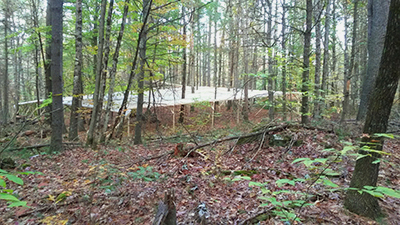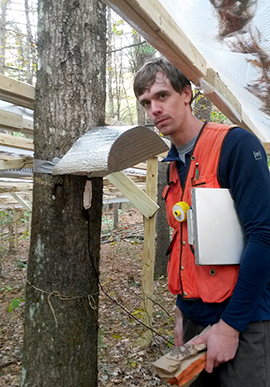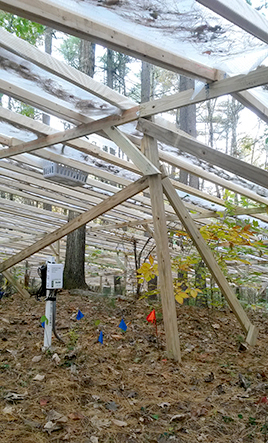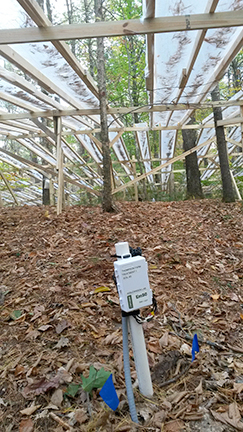Winter/Spring 2016
Earth Systems Science
A large-scale forest experiment at UNH's Thompson Farm Observatory aims to induce drought conditions in anticipation of changing climate
IF YOU WERE TO HAPPEN UPON the drought experiment recently set up in a forest plot at UNH's Thompson Farm Observatory in Durham, from a distance you might visualize an elaborate environmental sculpture that aims to create a alternate dimension and give added aesthetic depth to a temperate forest environment—one that accentuates a horizontal element of a largely vertical space and arrests falling leaves in midflight before they flutter to the forest floor to begin the cycle of decay and replenishment.
But get closer to the 9,700-square-foot (900 square meter) raft of 2x4s and high-durability polymer fabric and you’ll see the white plastic Em50 Data Logger protruding from a PVC pipe sunk into the pine-needle and oak-leaf-laden soil. “Thompson Farm, Treatment 1, Soil #3, Asbjornsen Lab” is written on the data logger and buried beneath it are three soil sensors at varying depths.
 |
|
| The Thompson Farm throughfall manipulation structure on one of the treatment plots designed to remove 55 percent of incoming precipitation.
Photo by David Sims, UNH-EOS. |
As a whole, the forest structure is indeed very artful-looking, but what’s happening here is unique, cutting-edge science that aims to put fine numbers on how drought affects the ecosystem of a temperate forest—from soil moisture content and microbes up to the leaf pores, or stomata, that regulate a tree’s water usage.
The four-year “forest throughfall manipulation experiment” that is just getting underway will try to simulate a 55-percent reduction in the annual growing season precipitation that falls on the forest floor.
While there are drought experiments, including those that are part of the National Science Foundation-funded Drought-Net global network (as the Thompson Farm experiment will be), most of these are in environments with short vegetation like grasslands where drought can be more easily induced; put simply, there are no trees to get in the way.
Drought experiments in temperate forests are few and far between. The only other one in the region is the Hubbard Brook Experimental Forest in New Hampshire’s White Mountains and was the first such experiment that sought to standardize the current methodology. The Thompson Farm throughfall structure is four times the size of Hubbard Brook. The project was made possible by a grant through the New Hampshire Agricultural Experiment Station.
 |
|
| Ph.D .student Cameron McIntire checks on a soil moisture sensor modified to measure sapwood water content in a northern red oak. Photo by David Sims, UNH-EOS. |
Ph.D. student Cameron McIntire of Heidi Asbjornsen’s ecohydrology lab in the Earth Systems Research Center is heading up the effort—Asbjornsen is the principal investigator of the project. Ecohydrology is an interdisciplinary field that studies the interactions between water and ecosystems.
“We’re trying to simulate a moderate-to-severe drought in a temperate forest ecosystem,” says McIntire, whose Ph.D. work involves the tree physiology of white pine—one of the dominant species along with red oak in the Thompson Farm plot.
To do so, McIntire dug into precipitation records for the region back to 1900 to find the top one percent of the driest years based on the 100-year record.
“I compiled all the precipitation data and looked at the driest years and then the top one percentile of that and it ended up correlating to years in the early 1960s when we had a severe drought,” he says.
To recreate the 60s drought conditions, McIntire and company will have to remove some 55 percent of the rainfall that would typically fall through the trees and reach the ground. The “throughfall” structure that is now in place will achieve this by, in fact, not allowing this percentage of rain—or close to it—to fall through and reach plot’s layer of soil.
“The 60s drought was about half of what we get in a normal year so the structure will remove somewhere between 55 to 60 percent of throughfall, which is the rain that doesn’t get intercepted by the forest canopy or runs down stems and hits the ground,” McIntire explains.
He adds, “We’ll capture all the water that falls through and then have a system that funnels it away from the plot to where we can collect and quantify it. So we’ll be validating the experiment both by measuring the soil moisture and measuring the amount of water that actually comes out of it.”
The all-important soil moisture measurements will be made by four of the soil sensors located strategically in four places 120-degrees apart around the 900-square-meter plot. And each sensor will take measurements at four different soil depths—5, 10, 20, and 30 centimeters.
“We have a lot of replication for the soil moisture measurements by design,” McIntire says. “We really want to be able to validate whether the experiment is working or not and how water is percolating through different layers of the soil, so it’s one of the most important aspects of it. And the soil moisture measurements end up being the most expensive aspect of this project.”
There is additional and critical replication and validation that will make this unique experiment that much more robust: a replicate throughfall structure plot located about a half mile away to compare and validate the data from the first plot, and a full year’s worth of “pretreatment data” gathered by soil and sap flow sensors installed and tree cores taken at the site prior to the throughfall structure being built.
“Not many researchers get pretreatment data before they put in a field experiment like this because it takes a lot of time and effort. We’ve managed to do that and it will be great from a statistical standpoint because we’ll be able to compare the two datasets,” McIntire says.
He adds that a big criticism with these experiments is that if researchers do end up seeing a difference between two plots, people might say, ‘How do you know those plots weren’t just different from the get-go?’ Says McIntire, “Now, we can at least show the difference from the beginning and when we do the statistical analysis four years later we’ll have something to compare to and validate the data.”
Forests make up the majority of New Hampshire’s land cover and are an essential part of the state’s natural resource base and economic livelihood. Understanding how to better manage them in a changing climate is crucial for maintaining a healthy balance of natural resources and economic growth.
 |
|
| Series of parallel troughs capture rainfall and funnel it away from the treatment plots where is can be measured and diverted.
Photo by David Sims, UNH-EOS. |
Both temperature and average annual precipitation are projected to increase in the state over the next century. Indeed, total annual rainfall has already increased more than nine percent over last century and is projected to increase another seven to 14 percent by 2100.
Notes McIntire, “All of the predictions are saying we’re going to see an increase in total rainfall, so you might be thinking, ‘Why measure drought?’ But what we’re predicting, and actually seeing in the last few years, is that most of those rain events are coming in the wintertime and it’s warmer, so we’ll have more rain and less snow in winter and we’ll see longer durations between those rain events. So, for example, we might get a big pulse and not get another rain event for several weeks to a month, and this can dramatically alter the ecohydrology of the ecosystem.”
During the growing season, longer periods without rainfall threaten summer water availability, and water stress in plants adapted to a cooler climate will be exacerbated by hotter summer temperatures. Water is not typically regarded as a limiting resource in New Hampshire’s forested ecosystems and thus the impacts of a moderate to severe drought in the region are largely unknown.
“Our experiment will run the entire year but we’re mostly interested in growing-season water availability because plants aren’t really using water during winter, McIntire says.
The experiment will allow the researchers to measure growth response of trees subjected to a water-limited climatic regime and quantify the impacts this may have on tree health, water use, carbon sequestration, and production of wood products such as timber and bioenergy feedstock.
“One of the things we do expect to see is significant growth reduction, which we will be able to gauge by the pre-treatment tree cores we’ve taken,” McIntire notes.
The work will enhance understanding of how forests will respond to anticipated climate change-induced alterations in rainfall regime and the influence it may have on the ecosystem services (i.e. water quality and quantity), quality of life and economic security in the region, with particularly important implications for foresters, land managers, and landowners.
Drought-Net, led by Melinda Smith of Colorado State University, is developing a standardized and relatively inexpensive method for conducting drought experiments in both grassland and forest ecosystems as part of an effort to establish a global network of drought experiments across diverse ecosystems worldwide.
“To date,” notes Asbjornsen, “there are many low-stature grassland and shrubland research sites participating in this network but forest sites are still poorly represented.”
Both the Thompson Farm and Hubbard Brook drought experiments were implemented to test different methodologies for conducting throughfall manipulations, according to Asbjornsen.
Challenges faced when conducting drought experiments in forest ecosystems include removing snow during winter months, designing the infrastructure to withstand falling branches and go around tree stems, keeping costs relatively low despite the need for more elaborate infrastructure and larger size plots, and ensuring that trees do not have access to water supplies outside of the plot or from deeper soil layers.
McIntire notes that great care was taken to make sure trees were not getting access to water outside the treatment plots by establishing them in areas in which the topography of the landscape ensured little or no movement of soil water laterally into the soil layers beneath the structure. For example, one treatment plot is oriented atop the center of a small knoll, while the replicate plot sits at the apex of a moderate slope. Additionally, a five-meter buffer was applied to the perimeter of the drought structures in order to account for the horizontal extension of tree roots.
Says Asbjornsen, “The results of these two UNH drought experiments are now being synthesized into a standard protocol designed specifically for forest ecosystems, which will be used to encourage researchers worldwide to establish similar experiments across a wide range of climate conditions and ecosystem types.”
